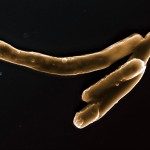Link to Pubmed [PMID] – 18808383
Mol. Microbiol. 2008 Nov;70(3):762-74
Mycobacterium tuberculosis and other pathogenic mycobacterial species produce large amounts of a glycogen-like alpha-glucan that represents the major polysaccharide of their outermost capsular layer. To determine the role of the surface-exposed glucan in the physiology and virulence of these bacteria, orthologues of the glg genes involved in the biosynthesis of glycogen in Escherichia coli were identified in M. tuberculosis H37Rv and inactivated by allelic replacement. Biochemical analyses of the mutants and complemented strains indicated that the synthesis of glucan and glycogen involves the alpha-1,4-glucosyltransferases Rv3032 and GlgA (Rv1212c), the ADP-glucose pyrophosphorylase GlgC (Rv1213) and the branching enzyme GlgB (Rv1326c). Disruption of glgC reduced by half the glucan and glycogen contents of M. tuberculosis, whereas the inactivation of glgA and Rv3032 affected the production of capsular glucan and glycogen, respectively. Attempts to disrupt Rv3032 in the glgA mutant were unsuccessful, suggesting that a functional copy of at least one of the two alpha-1,4-glucosyltransferases is required for growth. Importantly, the glgA mutant was impaired in its ability to persist in mice, suggesting a role for the capsular glucan in the persistence phase of infection. Unexpectedly, GlgB was found to be an essential enzyme.



